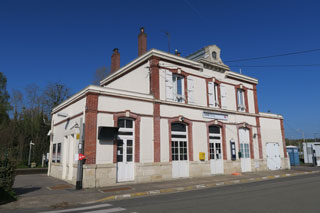Prochain point : lat="49.103321" lon="1.969748"

THE OLD SUGAR FACTORY AND THE TRAIN STATION
19th Century Constructions
A railway line...
The railway line linking Paris to Le Havre via the Seine valley was built between 1843 and 1847. The Dieppe service was opened in 1848. Later, the proposition of a more direct route via Gisors was retabled in order to offer a better service to travellers going to England. This line, called “des Plateaux” went from the north of Paris, stopping at Saint-Denis, Pontoise and Vexin français before branching into three lines at Gisors, towards Rouen, Le Havre and Dieppe respectively. The line was granted to the Western railway company (Compagnie des chemins de fer de l'Ouest) by the decree of June 11, 1859. The first train on the line arrived in Gisors on Tuesday September 15, 1868, via the stations Pontoise, Boissy, Us, Chars, Liancourt, Chaumont and finally Gisors. Smaller stops would later be added. At that time, there was only one track. Four trains travelled everyday in each direction, and there were often delays, leading the track to be doubled in 1909. Three years later, there would be ten trains travelling in each direction.
…stopping at the sugar factory
The “Société de la Sucrerie de Magny-en-Vexin” was founded in 1869 by Paul Corbin. With the creation of the Us sugar factory, the company changed its name to Société des Sucreries d’Us et de Magny-en-Vexin in 1872. The Us sugar factory began operations in 1873. Both factories worked together until 1908, when the Magny sugar factory became a simple transfer point, sending all its sugar beets to Us via rail.
Sewed after the winter frosts, sugar beets were harvested from October to January. The sugar factories operated mainly in winter, that is, when water flows were greater than what was required for the mills. However, conflicts arose around water use due to pollution generated by the factories on several occasions. The sugar factory closed in 1977.



